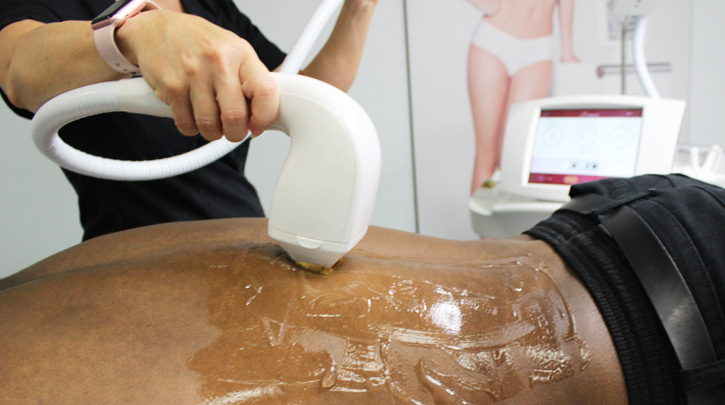The field of medical aesthetics is constantly evolving. New technologies, techniques, and treatment protocols are leading to a higher return on investment (ROI) for the provider, less risk and discomfort for the patient, and improved results that benefit both the patient and your before-and-after photo galleries. Naturally, this progression has led not only to more convenient non-invasive medical aesthetic treatments, but also an improved focus on skin tone. While older medical aesthetic systems were thought to be too risky for darker skin, new devices and protocols are becoming more centered on providing optimal treatment results to patients with a wider range of skin types. Here, we break down any risks to consider when treating patients with darker skin to ensure you are offering the optimal results, alongside the top medical aesthetic treatments for patients with darker skin tones.
Risks to Consider When Treating Darker Skin
Because laser therapies are used to target chromophores in the skin or hair, for decades, laser medical aesthetic treatments were used almost exclusively on patients with lighter skin tones. Medical aesthetic professionals have traditionally avoided these treatments for darker skin either because laser devices simply wouldn’t work (the device couldn’t distinguish between discoloration and healthy skin) or because of a high risk of post-inflammatory hyperpigmentation (PIH). PIH occurs when the skin reacts to inflammation or injury by over-producing melanin or dispersing pigment irregularly, rather than stimulating the creation of healthier skin cells by kickstarting skin’s natural healing cycle. Generally speaking, PIH appears as flat, discolored spots that are usually darker in tone than the surrounding skin. Luckily, new technologies offer features that allow treatment providers more control over the delivery of each treatment, meaning improved results for patients with darker skin and a much lower risk of PIH.
To manage risk and improve efficacy, there are two measurements treatment providers need to consider when treating darker skin tones: wavelength and pulse duration. Shorter wavelengths and pulse durations can risk damaging the epidermal layer and result in PIH or hypopigmentation (lightening of the skin), whereas longer wavelengths and pulse durations improve patient safety as energy is delivered over a relatively longer period of time, risking less intensity and damage to healthy tissue.
While performing a test spot should be routine with every patient, it is even more imperative in these instances. It may be beneficial to use various levels of intensity to evaluate skin’s reaction while remaining within the recommended treatment parameters to see what might be most effective and tolerated by the skin. Observe any reaction in the spot test area for 48-72 hours to determine if the tested treatment parameters are safe. Do not skip this waiting period, as pigmented skin is often delayed in showing response.
Top Medical Aesthetic Treatments That Are Safe for Darker Skin
Wrinkle Reduction
Regardless of tone, all skin is susceptible to photoaging. The sun’s UVA rays have a longer wavelength that easily penetrates through the epidermis and into the dermis where it affects collagen and elastin production. This results in the creation of an enzyme that often causes malfunctions that lead to collagen and elastin degradation. On the surface, these effects appear as wrinkles and loose skin. Combined with a lack of adequate SPF under the assumption that darker skin tones aren’t as sensitive to the sun, treatment providers may see an increase of patients with darker skin seeking out wrinkle reduction treatments.
Wrinkle reduction treatments utilizing a synergistic combination of Multi-Polar Radio Frequency (RF) and Pulsed Electro Magnetic Fields (PEMF) technologies may be the perfect solution for these patients. Safe for all skin tones, Multi-Polar RF delivers heat deep below the skin’s surface, stimulating fibroblasts for improved collagen production. Meanwhile, PEMF is proven to promote the formation of new blood vessels while inducing fibroblast proliferation via an increase in growth factor FGF-2 to support improved collagen synthesis. Advanced safety features, like Automatic Temperature Control (ATC) on the Venus Freeze Plus™, allows for greater operator control over target temperature selection, helping to further improve patient safety. The result is smoother, firmer skin with a reduced risk of PIH and optimal results for improved patient satisfaction.
Hair Removal
Lasers have been in used in medicine for decades, but their application for hair removal only took hold in the 1990s. Early lasers were typically very slow and painful, and they only worked on people with dark hair and fair skin. Today, four types of laser are generally used for hair removal, each employing a different medium to amplify optimal power: ruby, alexandrite, Nd:YAG, and diode lasers. While a more complete summary of hair removal for patients with dark skin can be accessed here, diode laser hair removal treatments are generally seen as the safest and most effective modality for treating a wider range of Fitzpatrick skin types. For example, a 2015 comparative study of Nd:YAG and diode lasers concluded that diode laser technology offered the best results for patients with darker skin and darker hair with 92% hair reduction after eight sessions. Diode lasers use longer wavelengths that penetrate more deeply into the skin, reducing the amount of energy absorbed by melanin in the epidermis relative to the hair follicle. Diode lasers also offer a faster repetition rate, allowing for quicker treatment of larger areas.
Skin Resurfacing
Once well off limits for patients with darker skin, today’s RF-based skin resurfacing treatments are now a good choice for treating PIH. While non-fractional CO2 laser treatments used to be the gold standard for skin resurfacing, these treatments risked further damage to darker skin, with PIH occurring in about 40% of patients with darker skin tones. A safer skin resurfacing option for darker complexions, fractional RF devices like the Venus Viva™ are worth a closer look. Utilizing NanoFractional RF™ technology, Venus Viva™ skin resurfacing treatments deliver energy deep below the skin’s surface through needle-shaped pin tips. For starters, RF is proven to be safe for all skin tones. In addition, due to the small size of the tips and more homogeneous energy delivery, the Venus Viva™ system can ensure high enough energy delivery to be effective without further risking PIH.
The Bottom Line
Unfortunately, many prospective patients with darker skin tones may believe in all the myths about medical aesthetics that say they are far from the ideal candidate. However, with the right technology, you can easily capture the attention of these prospective patients and inform them that with the right laser and under the care of a knowledgeable practitioner, previous contraindications no longer need to be an obstacle to their aesthetic goals. Offering safe and effective treatments to an underserved demographic could also prove to be a strong business move for your clinic.
Ensure your clinic is well equipped with continuing clinical education and industry-leading technology with Venus Concept. With a range of compact tabletop devices and multi-treatment platforms offering treatments that are safe for darker skin tones, we have the perfect solution for your clinic. Contact an expert to learn more today.
Practice Enhancement Tips






